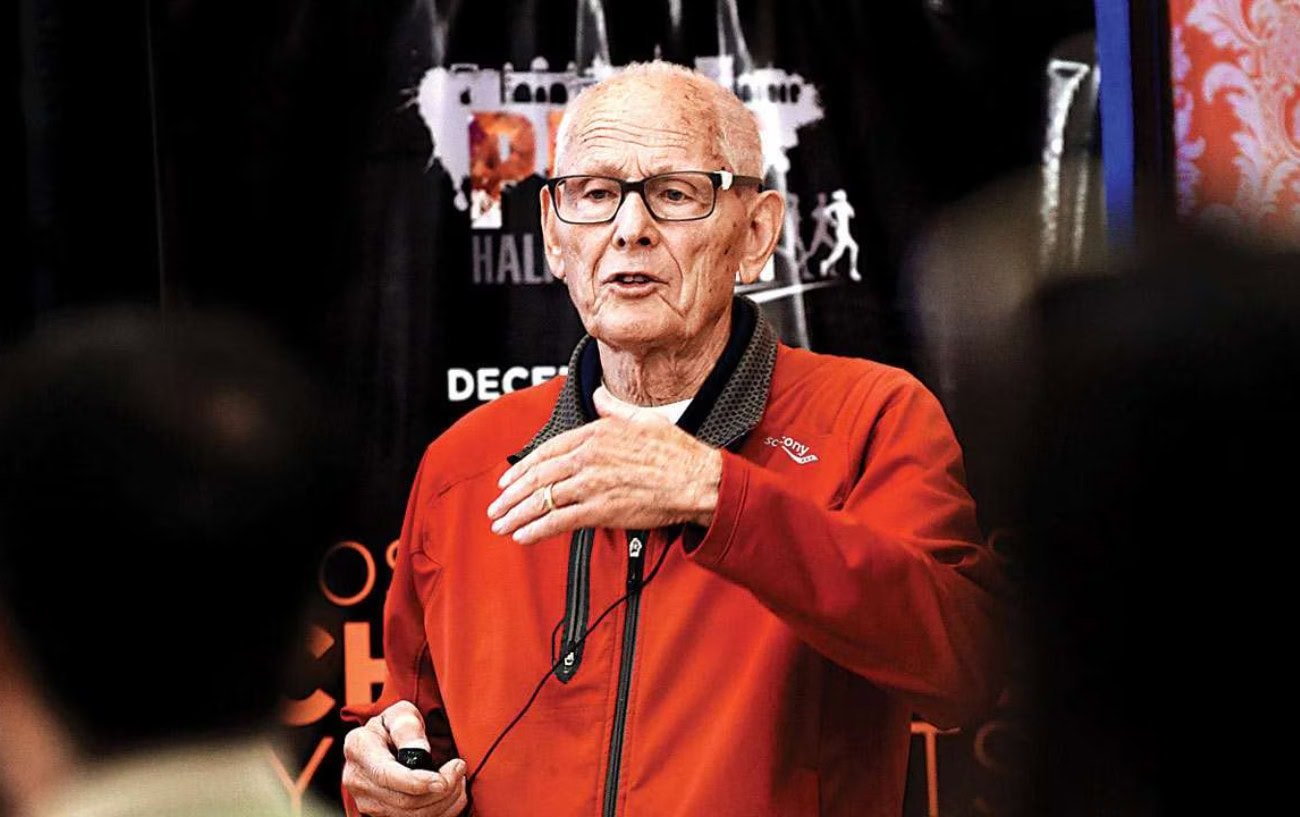Cadence—also called stride rate, step rate, or stride frequency is simply the number of steps you take per minute while running, and it plays a key role in your overall running efficiency and even injury risk.
To calculate it, count how many times your right foot hits the ground in one minute, then double that number. For example, if your right foot lands 85 times in 60 seconds, your total cadence is 170 spm. Also, most fitness trackers and watches calculate this metric for you while you run.
Most efficient distance runners fall within the 170–180 spm range, but the “ideal” cadence isn’t the same for everyone. Instead of chasing a magic number, the goal should be to gradually increase your cadence if it’s on the lower side, especially if you tend to overstride.
A slightly quicker cadence usually helps reduce impact, improve running economy, and promote smoother, more efficient movement.
So, how do you improve your cadence—and should you? Let’s take a closer look.

What Is A Good Running Cadence?
As with many aspects of running form or running technique, there isn’t a one-size-fits-all approach, “best stride rate,” or “perfect stride frequency” for all runners.
Many running coaches suggest that the ideal running cadence is in the 170-180 spm range, but it will vary from runner to runner.
Several factors will affect the ideal cadence for a runner, including the following:
#1: Sprinting Vs. Long Distance Running
Generally, sprinters demonstrate a longer stride length coupled with a higher cadence because the race is so short, and power, acceleration, and ground contact time are all critically important.
For distance running, running speed will impact what constitutes a good running cadence.
Typically, long-distance runners—such as those training for a half marathon or marathon—will want to land on their midfoot and use a higher stride frequency, but we tend to see distance runners (recreational distance runners) overstriding and heel striking.
#2: Leg Length
Because taller runners have longer legs, they can use a comparatively lower cadence and greater stride length than a short runner while still not overstriding.
#3: Terrain
Trail running typically requires a faster cadence with short, quick steps rather than long, loping strides with a low cadence.
Similarly, a higher stride frequency and shorter step length require less energy as you ascend the hill.
In contrast, for downhill running, you can lengthen your stride because you are working with gravity, so a low cadence can be more appropriate and will use less energy.

Why Overstriding May Be Slowing You Down
Many recreational runners are interested in improving their running form to reduce the risk of injury, enhance their running economy, and ultimately run faster.
Interestingly, although all of these goals can theoretically be addressed simultaneously by working on increasing your stride rate or running cadence, many recreational runners assume that their stride length is actually too short and that by increasing stride length, they will achieve a smoother running stride, similar to that of elite runners.
However, in fact, one of the most common issues with running mechanics or form for many recreational runners is overstriding, which means the stride length is too long.
Overstriding (heel striking) can decrease your running speed and running economy, and more importantly, overstriding increases ground contact time and impact stresses, and therefore increases the risk of injury.
With overstriding, or heel striking, the stride length is ultimately too long, which means that the runner is extending the leading leg too far forward relative to their center of mass while running.1DAOUD, A. I., GEISSLER, G. J., WANG, F., SARETSKY, J., DAOUD, Y. A., & LIEBERMAN, D. E. (2012). Foot Strike and Injury Rates in Endurance Runners. Medicine & Science in Sports & Exercise, 44(7), 1325–1334. https://doi.org/10.1249/mss.0b013e3182465115
Then, instead of having the tibia (shin) in a relatively vertical position as they are just about to land on the foot, the tibia is angled forward with the heel pointing down.
This ends up causing them to land on the heel instead of the midfoot or the ball of the foot because the toes are pointing up and away, and the stride length is too long.
So, what is the problem here?
From a running economy standpoint, overstriding wastes energy because you compromise your forward momentum.
If you can recall back to physics class, when you apply a force with a direction (think vectors) to the ground, the ground pushes back with the same amount of force in the equal and opposite direction.2Hall, N. (2023, August 7). Newton’s Laws of Motion. Glenn Research Center; NASA. https://www1.grc.nasa.gov/beginners-guide-to-aeronautics/newtons-laws-of-motion/
If a runner is overstriding, the shin, knee, thigh, and hip complex are all angled backward relative to the ground at heel contact.
Therefore, instead of helping to propel you forward, the ground pushes backward on the body.3Souza, R. B. (2016). An Evidence-Based Videotaped Running Biomechanics Analysis. Physical Medicine and Rehabilitation Clinics of North America, 27(1), 217–236. https://doi.org/10.1016/j.pmr.2015.08.006
Not only are you conserving the momentum you are generating, but you are actually having to work against a force that is pushing you backward.

Increasing your running cadence or stride rate can help decrease your stride length.
When your legs are moving faster and taking more steps per minute, the spread of those steps, so your step length or stride length, shortens and quickens.
Then, when the leading leg advances forward in the air during the swing phase, it isn’t extended so far out in front of your body that your shin is angled relative to the ground, and your heel is pointing down.
Instead, your shin drops vertically, closer to your center of mass, setting you up for a midfoot strike at ground contact.
Landing on your midfoot and using a shorter stride length uses less energy because, now, returning to our concept of vectors in physics, the ground isn’t pushing backward on your foot. Instead, it springs you right back up in the forward direction, ready to advance your body for the next running step.
Another problem with overstriding or heel striking is that it increases ground contact time.
Because you are landing on your heel, and your body is further behind your foot, your foot stays on the ground longer as your center of mass has to travel from further back behind the heel to over the midfoot before pushing off on your toes.
Greater ground contact time while running has been shown to decrease stride efficiency, decrease running economy, and compromise running speed.
In contrast, the longer you are in the “flight phase“ of running, meaning that both feet are off the ground, the faster you will run.
Elite runners have a very short ground contact time, accompanied by a higher stride frequency.
Using a faster cadence and shorter stride length will help you become a better runner from a speed and efficiency standpoint, and it can also help with injury prevention.
Evidence suggests that increasing stride length can increase the risk of injuries by increasing impact or loading forces.4Baggaley, M., Vernillo, G., Martinez, A., Horvais, N., Giandolini, M., Millet, G. Y., & Edwards, W. B. (2019). Step length and grade effects on energy absorption and impact attenuation in running. European Journal of Sport Science, 20(6), 756–766. https://doi.org/10.1080/17461391.2019.1664639
In contrast, research suggests that increasing your cadence by about 5-10% can reduce the risk of injuries.5Heiderscheit, B. C., Chumanov, E. S., Michalski, M. P., Wille, C. M., & Ryan, M. B. (2011). Effects of step rate manipulation on joint mechanics during running. Medicine and Science in Sports and Exercise, 43(2), 296–302. https://doi.org/10.1249/MSS.0b013e3181ebedf4
There is less impact stress on the foot and leg when you land on your midfoot, less braking force, and less vertical ossification (bouncing motion).

Essentially, a higher cadence allows quick, light steps and keeps your feet closer to your center of mass.
Additionally, as discussed, having a shorter stride length and taking a greater number of steps per minute rather than using longer strides with a low cadence decreases ground contact time.
We discussed that this can help you be a better runner by supporting a more efficient stride and faster running speed, but it can also decrease the risk of running injuries. As the number of steps per minute increases and the ground contact time decreases, every step has less impact.
Essentially, using a running technique with a higher cadence allows the runner to land lightly and quickly on each foot, rather than taking heavy, trodding steps where the heel crashes into the ground and the foot is almost stomping or slapping into the road.
If you’ve ever seen (or heard!) a recreational runner running on a treadmill at the gym, you might have even heard the slap, slap, slap of their feet seemingly banging down on the running deck rather than gliding lightly with quiet, smooth running steps.
For the most part, if we were watching or listening to an elite runner on the same treadmill, they would be using a higher average cadence, with less contact time, less impact, and less energy, resulting in an overall more efficient runner.

How Do You Improve Your Running Cadence?
#1: Use a Metronome App or Music
Metronome apps such as Smart Metronome and Run Tempo are one of the best ways to not only monitor the number of times per minute you are landing on your feet (spm), but also to help be methodical and more gradual in your progression towards changing your average cadence for long-distance running.
After your warm-up, turn on the metronome and dial it down until the bpm matches your current running cadence. Then, start to increase the bpm by 5% and try to maintain the higher running cadence for just the next mile.
Gradually increase the percentage of your run at this faster stride rate until the whole run after the warm-up is at the new cadence.
You can also use music to help you hit your stride. Try creating a playlist with songs that match the step rate you’re aiming for—say, 170 to 180 beats per minute.
Just be cautious: many popular songs labeled at a certain bpm don’t actually match the full stride rhythm you’re targeting.
It’s worth taking the time to verify the tempo and build a playlist with songs that truly match your desired cadence. Once dialed in, running to the beat can make finding your rhythm feel more natural—and a lot more fun.
#2: Run Strides
One of the most effective and accessible ways to improve your running cadence is by incorporating strides at the end of your easy runs.
Strides are short accelerations, typically about 20 to 30 seconds, where you gradually build up to about 90–95% of your maximum speed and then ease back down. The goal isn’t to sprint all-out, but rather to focus on good form, smooth acceleration, and fast, controlled turnover.
During each stride, imagine running over hot coals—light on your feet, fast steps, and minimal ground contact. This visualization can help promote a quicker cadence and more efficient foot strike. Focus on keeping your arms relaxed, your posture tall, and your steps short and snappy.
Start with four strides after your next few easy runs, allowing full recovery between each. Over time, this neuromuscular training reinforces quicker turnover and makes a higher cadence feel more natural when you’re running at all paces.
#3: Pump Your Arms
Your arm swing helps drive your stride, and when you deliberately pump your arms faster, your legs will naturally follow suit to stay in sync.
During runs where you’re working on cadence, especially strides or speed workouts, focus on a quick but controlled arm swing. Keep your elbows bent at about 90 degrees, hands relaxed (imagine holding a potato chip you don’t want to crush), and drive your arms back and forth, not across your body.
Think rhythm and momentum, a faster, compact arm swing creates a higher cadence and encourages lighter, quicker steps. Use this consciously during efforts when you’re trying to improve turnover, and over time, it’ll become automatic.
#4: Run Downhill
Downhill running is a powerful tool for improving cadence because gravity naturally encourages quicker leg turnover. Incorporating short, controlled downhill strides can help train your body to run with a faster stride frequency.
Look for a gentle, smooth slope, with nothing too steep. After a warm-up, do 4–6 short strides downhill (approximately 50–100 meters). Focus on staying light on your feet, quick with your steps, and maintaining good form. Don’t overstride or lean back.
These strides help your brain and body adapt to moving your legs faster, which you can gradually replicate on flat terrain over time.
#5: Shorten Your Steps
One of the most effective ways to improve your cadence is to shorten your stride length slightly.
When your steps are too long, your foot tends to land too far in front of your body, which slows you down and increases impact forces. By shortening your stride, you naturally increase your stride rate to maintain the same pace, which promotes better efficiency.
Focus on landing your foot underneath your center of mass, not out in front. Quick, light steps with minimal ground contact time should be the goal. You don’t have to make a drastic change—just trimming your stride a bit can help you run smoother and more rhythmically.
When it comes to improving your cadence, slow and steady wins the race. Making small, consistent adjustments gives your body time to adapt to the new demands without overloading muscles and joints.
A gradual shift in stride rate and form is not only more sustainable but also helps reduce the risk of injury while enhancing your overall running efficiency.
If you are looking to improve your running form in general, check out this next video:














Hi Thomas and everyone at Marathon Handbook.
I just wanted to say thanks for providing me with the information and guidance I needed to run my first Marathon (Manchester, UK, 10th Oct 2021) and to go sub-4 hours. The training plan worked like a dream. I used the 8,46 rule for as long as I could and that left enough in the tank to reach my goal depsite a major slow down over the last 8 miles. I can now say I am in the sub-4 crew for the rest of my life, which is amazing.
Congratulations, Dan. The 3hr marathon is a goal that, once reached, helps a runner to understand that proper training can open up incredible performances. You will be pleasantly surprised to see your times now come down more easily, as you have gotten over the mental barrier of the 3hr goal. Go get em! Coach Terry Hamlin
Hi. I always read these very interesting articles but in the end over the years I’ve learnt to listen to my body rather than a myriad of sometimes conflicting advice. I was once told by the physio dep at norwich. I should be able to run for a bus let alone run marathons. And yet after a couple of years I regularly knocked out sub 2.45 marathons pb of 2.35 and half marathons of between 1.10 to 1.12 as a club runner. I was happy with that. So yes read and absorb but listen to your inner self! Great stuff!
I loved this article on cadence. I’m over 80 and ultra- runner, and still having fun running. Its articles like this one that helps me stay out there for fun just like a kid! Thanks!!
Good insights but I’m just wondering is heel strike that bad as long as if you do not overstriding? As a matter of fact most runners Heel Strike isn’t it as a significant majority (70-90%) of distance runners, including many elites, are natural heel strikers based on general researches.